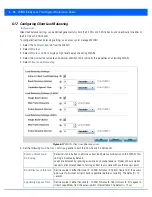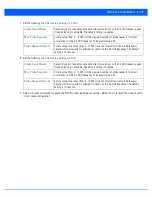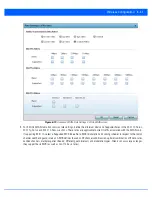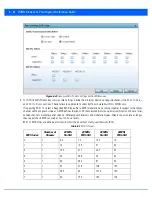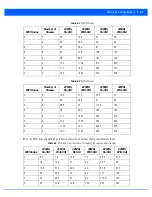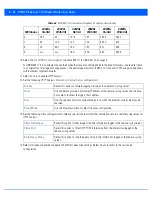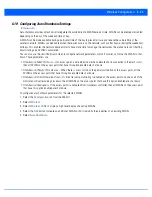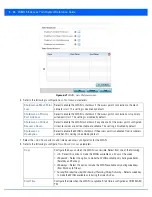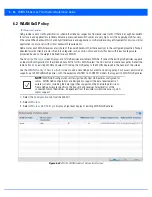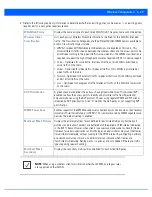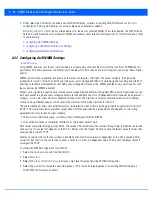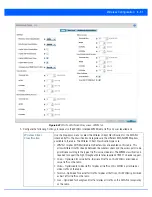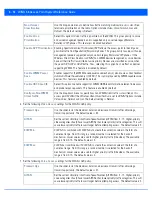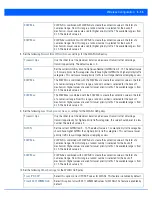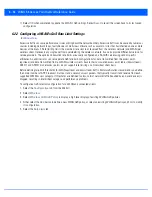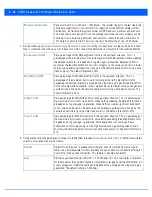
6 - 52 WiNG 5.6 Access Point System Reference Guide
6. Set the following
Video Access
settings for the WLAN’s QoS policy:
7. Set the following
Voice Access
settings for the WLAN’s QoS policy:
Non-Unicast
Classification
Use this drop-down menu to define how traffic matching multicast masks is classified
relative to prioritization on the radio. Options include
Video, Voice, Normal, Low
and
Default
. The default setting is Default.
Enable Voice
Prioritization
Select this option if
Voice
traffic is prioritized on the WLAN. This gives priority to voice
and voice management packets and is supported only on certain legacy Motorola
Solutions VOIP phones. This feature is disabled by default.
Enable SVP Prioritization
Enabling
Spectralink Voice Prioritization
(SVP) allows the access point to identify and
prioritize traffic from Spectralink/Polycomm phones. This gives priority to voice, with voice
management packets supported only on certain legacy Motorola VOIP phones. If the
Wireless Client Classification is
WMM
, non-WMM devices recognized as voice devices
have all their traffic transmitted at voice priority. Devices are classified as voice, when
they emit
SIP
,
SCCP
or
H323
traffic. Thus, selecting this option has no effect on devices
supporting WMM. This feature is disabled by default.
Enable WMM Power
Save
Enables support for the WMM based power-save mechanism, also known as
Unscheduled
Automatic Power Save Delivery
(U-APSD). This is primarily used by WMM capable voice
devices. This feature is enabled by default.
Enable QBSS Load IE
Select this option to enable support for WMM QBSS load information element in beacons
and probe response packets. This feature is enabled by default.
Configure Non WMM
Client Traffic
Use the drop-down menu to specify how non-WMM client traffic is classified on this
access point WLAN if the
Wireless Client Classification
is set to
WMM
. Options include
Video, Voice, Normal
and
Low
. The default setting is Normal.
Transmit Ops
Use the slider to set the maximum duration a device can transmit after obtaining a
transmit opportunity. The default value is 94.
AIFSN
Set the current
Arbitrary Inter-frame Space Number (AIFSN)
from 2 - 15. Higher-priority
video categories should have lower AIFSNs than lower-priority traffic categories. This will
cause lower-priority traffic to wait longer before attempting access. The default value is 2.
ECW Min
ECW Min
is combined with
ECW Max
to create the contention value in the form of a
numerical range. From this range, a random number is selected for the back off
mechanism. Lower values are used for higher priority traffic (like video). The available
range is from 0-15. The default value is 3.
ECW Max
ECW Max
is combined with
ECW Min
to create the contention value in the form of a
numerical range. From this range, a random number is selected for the back off
mechanism. Lower values are used for higher priority traffic (like video). The available
range is from 0-15. The default value is 4.
Transmit Ops
Use the slider to set the maximum duration a device can transmit after obtaining a
transmit opportunity. The default value is 47.
AIFSN
Set the current
Arbitrary Inter-frame Space Number (
AIFSN) from 2 - 15. Higher-priority
voice categories should have lower AIFSNs than lower-priority traffic categories. This will
cause lower-priority traffic to wait longer before attempting access. The default value is 2.
Summary of Contents for WiNG 5.6
Page 1: ...Motorola Solutions WiNG 5 6 ACCESS POINT SYSTEM REFERENCE GUIDE ...
Page 2: ......
Page 22: ...8 WiNG 5 6 Access Point System Reference Guide ...
Page 26: ...1 4 WiNG 5 6 Access Point System Reference Guide ...
Page 38: ...2 12 WiNG 5 6 Access Point System Reference Guide ...
Page 74: ...3 36 WiNG 5 6 Access Point System Reference Guide ...
Page 468: ...6 2 WiNG 5 6 Access Point System Reference Guide Figure 6 1 Configuration Wireless menu ...
Page 568: ...6 102 WiNG 5 6 Access Point System Reference Guide ...
Page 614: ...7 46 WiNG 5 6 Access Point System Reference Guide ...
Page 660: ...8 46 WiNG 5 6 Access Point System Reference Guide ...
Page 716: ...9 56 WiNG 5 6 Access Point System Reference Guide ...
Page 730: ...10 14 WiNG 5 6 Access Point System Reference Guide ...
Page 982: ...14 20 WiNG 5 6 Access Point System Reference Guide ...
Page 984: ...A 2 WiNG 5 6 Access Point System Reference Guide ...
Page 1046: ...B 62 WiNG 5 6 Access Point System Reference Guide ...
Page 1047: ......

